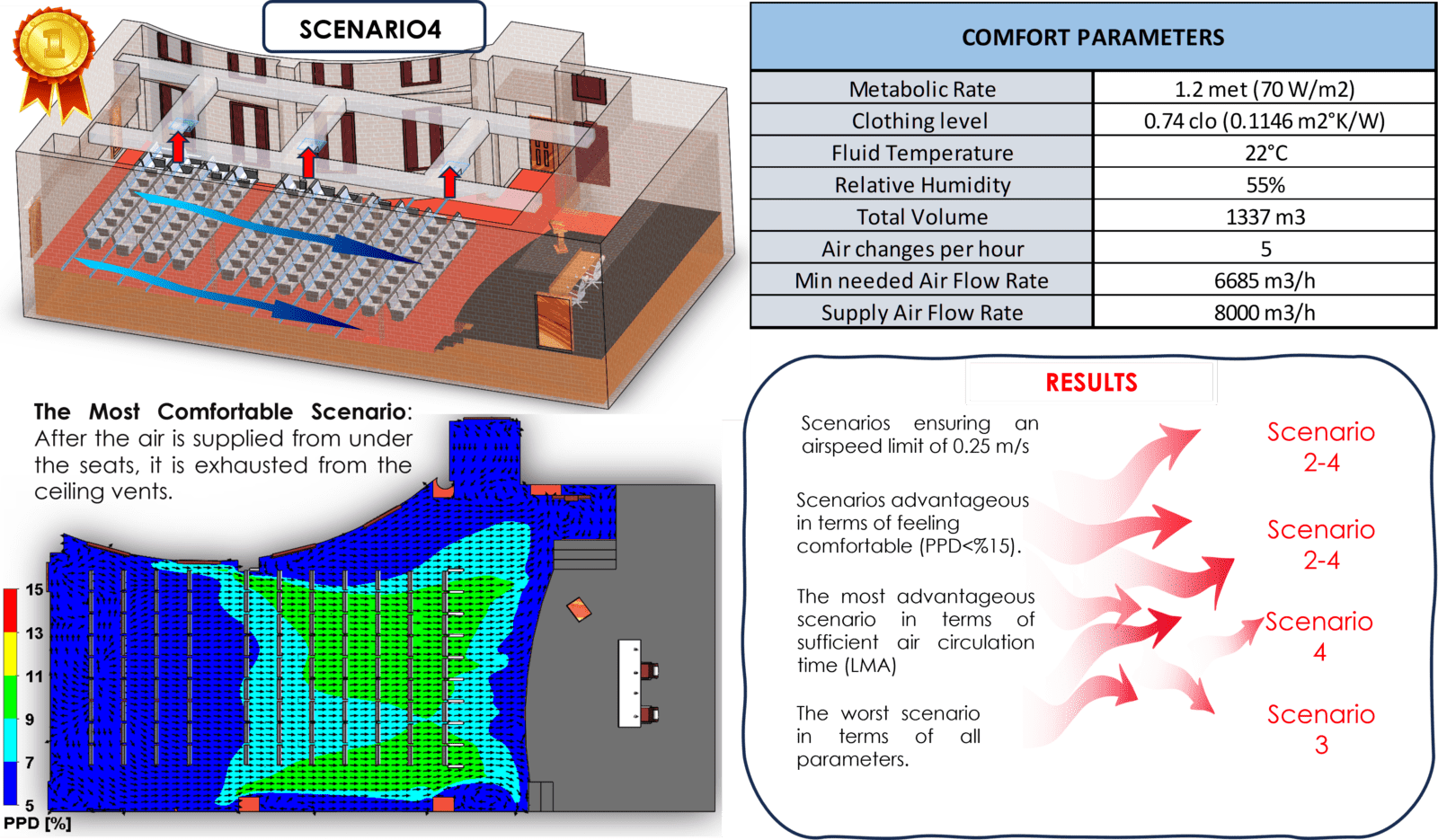
AMFI THEATER COMFORT ANALYSIS & CFD
It is critically important for audiences to feel comfortable in terms of thermal comfort and clean air in theaters or conference halls. Turning events whose main purpose is to keep the audience engaged into discomfort is an undesirable situation. The success of a performance not only relies on the talents of the actors but also includes their interaction with the audience. This interaction is closely related to the creation of the environmental conditions of the venue.
To achieve this balance, traditional Heating, Ventilation, and Air Conditioning (HVAC) systems alone are not sufficient. Even if enough fresh air is supplied to the entire auditorium, it is essential to have efficient placement of supply and return diffusers for the air to reach all spectators and for circulation to be ensured effectively.
At this point, advanced computational techniques such as Computational Fluid Dynamics (CFD) come into play. CFD simulates air movements inside conference halls, allowing interpretation of temperature distribution, airflow, and ultimately thermal comfort. Through these analyses, designers can identify temperature differences in different zones of the hall and, if necessary, implement appropriate HVAC systems to enhance thermal comfort and air quality. This allows for the identification of potential problems in the design process and the development of suitable solutions in advance.

CFD analyses offer various advantages to enhance the effectiveness of ventilation systems in theaters, cinemas, or conference halls.
Detailed Simulations: CFD can simulate factors such as indoor airflow, temperature distribution, humidity levels, and distribution of pollutants in detail. I t enables the identification of critical areas where hot air accumulates or airflow reaches uncomfortable levels. This allows designers to better understand and optimize indoor conditions.
Pre-assessment of Performance: CFD allows for the pre-assessment of a building or residence’s performance during the design stage. This enables designers to identify potential problems in advance and take corrective measures, leading to better results in real-world applications.
Enhancement of User Satisfaction: Better thermal comfort and air quality increase the satisfaction of building or residence users. This contributes to people spending longer periods indoors and overall improvement in quality of life.
Cost and Time Savings: Compared to traditional trial-and-error methods, CFD analyses are more economical in terms of cost and time. Designers can quickly evaluate many different scenarios to find the most suitable solution.
In the implementation of the analyses, air supply and exhaust were provided through different openings based on four different scenarios. A comparison was made among these orientations regarding the comfort of the audience.

Scenario 1: Air supply is provided from the side diffusers located in front of the stage, while air exhaust is conducted from the ceiling.
Scenario 2: Air supply is directed towards the ceiling at a 45° angle from the side diffusers located in front of the stage, while air exhaust is conducted from the ceiling. This aims to mitigate the discomfort caused by high-speed airflow for audience members in the front rows.

Scenario 3: Air is supplied vertically from the ceiling onto the audience, while air exhaust is conducted from the side diffusers located in front of the stage.
Scenario 4: Air is supplied from the lower parts of the stairs where audience seats are located, while air exhaust is conducted from the ceiling. This aims to minimize the discomfort caused by high-speed airflow by circulating the supplied air throughout the entire auditorium.
Let’s see who won?
During the comfort assessment, the most suitable scenario was determined by evaluating the following three different parameters (Velocity, PPD, LMA) to understand the conditions that provide the best comfort.

Air Velocity: Air blown at speeds exceeding 0.25 m/s while conditioning theater halls negatively affects the audience’s comfort. (Reference: Ashrae Standard 55-2023)

PPD (Predicted Percentage of Dissatisfied): PPD, which is a parameter of the interaction between the supplied air velocity and temperature and other heat sources in the environment, helps us understand how comfortable people generally feel in a space. The lower the PPD in a building or residence, the lower the likelihood of dissatisfaction. Thus, a low PPD value indicates that people are generally satisfied thermally, while a high PPD value indicates an increased likelihood of dissatisfaction. In a region where the PPD rate exceeds 15%, spectators do not enjoy the event, cannot focus, and may even want to leave the hall as soon as possible. (Reference: https://comfort.cbe.berkeley.edu/)

Local Mean Age (LMA): Another comfort factor is the aging of air after it enters the room. This parameter is particularly important for the removal of indoor humidity and pollutants (primarily carbon dioxide).

In all scenarios, it was observed that Scenario 4 was the most comfortable in terms of both Local Mean Age (LMA), regional air velocity, and Predicted Percentage of Dissatisfied (PPD). On the other hand, in Scenario 3, it was observed that there was a much higher sense of discomfort locally.
It is beneficial to determine the locations of air supply and exhaust well; otherwise, the design will be inefficient in terms of human comfort performance.



